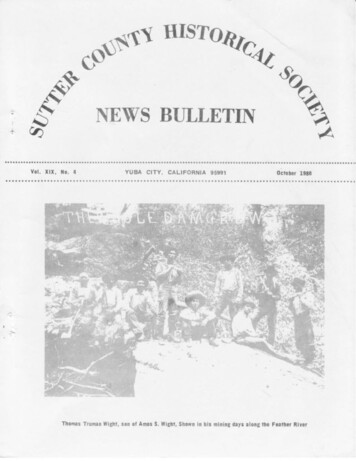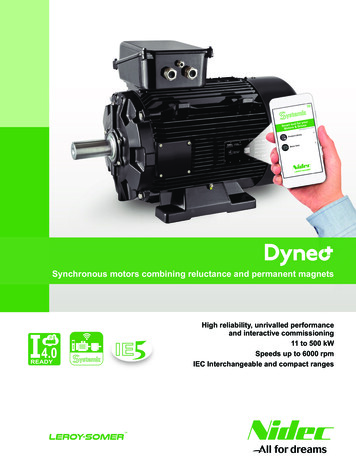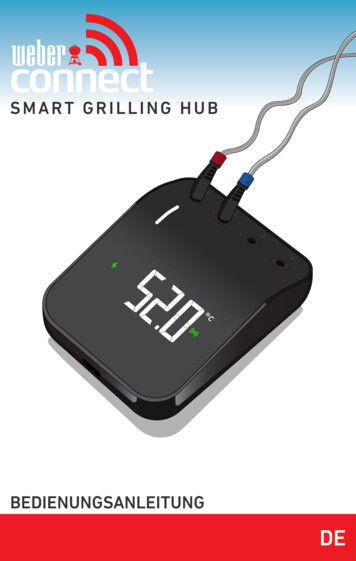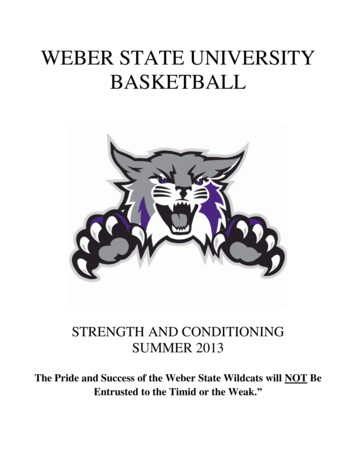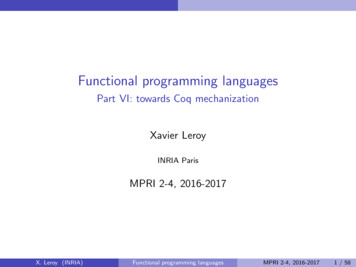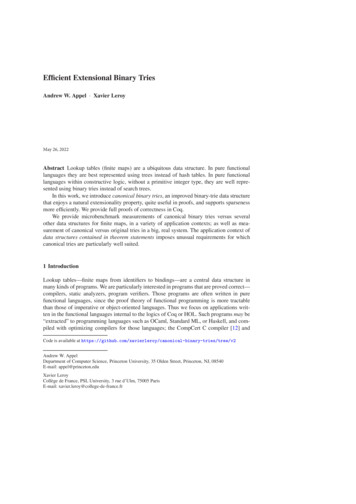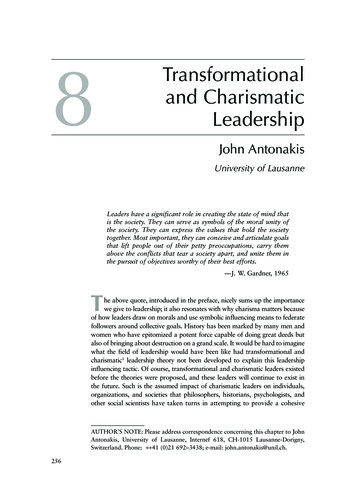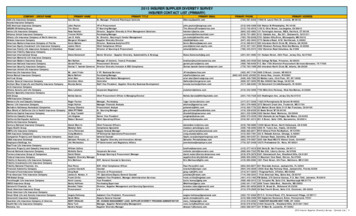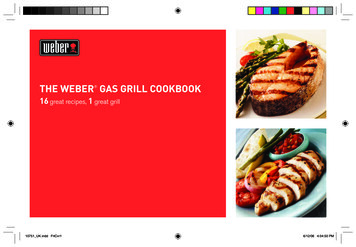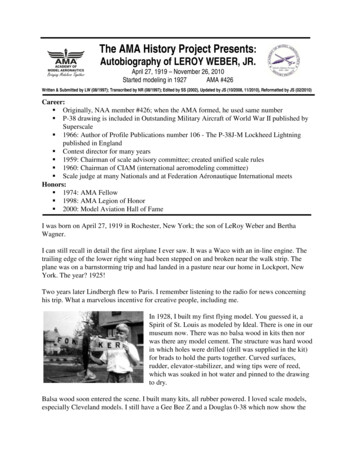
Transcription
The AMA History Project Presents:Autobiography of LEROY WEBER, JR.April 27, 1919 – November 26, 2010Started modeling in 1927AMA #426Written & Submitted by LW (08/1997); Transcribed by NR (08/1997); Edited by SS (2002), Updated by JS (10/2008, 11/2010), Reformatted by JS (02/2010)Career: Originally, NAA member #426; when the AMA formed, he used same number P-38 drawing is included in Outstanding Military Aircraft of World War II published bySuperscale 1966: Author of Profile Publications number 106 - The P-38J-M Lockheed Lightningpublished in England Contest director for many years 1959: Chairman of scale advisory committee; created unified scale rules 1960: Chairman of CIAM (international aeromodeling committee) Scale judge at many Nationals and at Federation Aéronautique International meetsHonors: 1974: AMA Fellow 1998: AMA Legion of Honor 2000: Model Aviation Hall of FameI was born on April 27, 1919 in Rochester, New York; the son of LeRoy Weber and BerthaWagner.I can still recall in detail the first airplane I ever saw. It was a Waco with an in-line engine. Thetrailing edge of the lower right wing had been stepped on and broken near the walk strip. Theplane was on a barnstorming trip and had landed in a pasture near our home in Lockport, NewYork. The year? 1925!Two years later Lindbergh flew to Paris. I remember listening to the radio for news concerninghis trip. What a marvelous incentive for creative people, including me.In 1928, I built my first flying model. You guessed it, aSpirit of St. Louis as modeled by Ideal. There is one in ourmuseum now. There was no balsa wood in kits then norwas there any model cement. The structure was hard woodin which holes were drilled (drill was supplied in the kit)for brads to hold the parts together. Curved surfaces,rudder, elevator-stabilizer, and wing tips were of reed,which was soaked in hot water and pinned to the drawingto dry.Balsa wood soon entered the scene. I built many kits, all rubber powered. I loved scale models,especially Cleveland models. I still have a Gee Bee Z and a Douglas 0-38 which now show the
signs of age – they were built in 193 4 and 1935!I won a contest with the 0-38 in 1935. The prize: a Baby Cyclone gas engine.In the mid 1930s, in Rochester, New York, the Times Union newspaper sponsored contests formodel airplanes. I flew models in several contests and won prizes in several classes.Having a motor now, my activities turned to power models. My first was a model RearwinSpeedster. My first power flight was off crusted snow on skis! Boy, were those engines hard tostart in the cold. They had batteries, spark coil, and condenser. I limited the engine run by usingan eyedropper for a fuel tank. It was messy but it worked. I was a lone model builder. I lived in asmall town. There were no model clubs. I devoured everything I could find to read aboutairplanes.There were model organizations in the various magazines. I joined the International Gas ModelAirplane Association and had license number IGM-0-109-1, IGM-0-109-2. Later the NationalAeronautic Association also had a model division and I was given NAA-426 as my license in1936. Soon thereafter AMA was born and I kept the license number, which I still hold.Being interested in scale, I continued my interest in full size planes. We visited every airport insight. In 1935, there was a dedication of the Donald Woodward Airport in Leroy, New York, atwhich many planes were present, including the Howard Ike, which I photographed. Much to mysurprise, my pictures have appeared in scale documentation presentations for this plane.I also went to the Cleveland Air Races in 1937 and saw Rudy Kling win the Thompson TrophyRace.I built quite a few competition type gas models, some of which I designed. In 1938, while I was astudent at Blair Academy in Blairstown, New Jersey, I went, with a fellow student, to the EasternStates Competition in Farmingdale, Long Island. It was a very windy day, but I had a plane I haddesigned which flew well in wind. I took third place in my first ever competition. The trophy Iwon is now in our museum.In 1936 while I was a student at Spencerport, New York High School, I organized an aviationclub of which I was president. In 1938 while I was a student at Blair Academy in Blairstown,New Jersey, I organized a model airplane club of which I also became president.In the fall of 1938, I became a freshman, class of 1942, at Colgate University with chemistry asmy major. In the summer of 1939, I enrolled in Parks Air College in East St. Louis, Illinois,studying aircraft engines. While I was there, World War II began. I returned to Colgate andcompleted two and one-half years. They initiated the n Pilot Training program while I was atColgate. I had started flight training while I was at Parks and had soloed there. At Colgate, Icompleted the flight program flying J-3 Cubs and earned a private pilot’s license in January1941. The Selective Service draft was calling men for military training. I decided I could offer
more in the aircraft industry. I got a job with Curtiss Aeroplane and Motor Co. in Buffalo, NewYork. They were building Navy SB2-C, 0-52, P-40 and C-46’s.In February 1941 Helen Burch from Auburn, New York, and I were married.My brother had been an inspector with Curtiss. I had started in Production but was soon asked tobe a parts coordinator. I had to see that parts were at each station of the P-40 line when they wereneeded. Parts were stored in a facility in the shop area and were distributed to the stations wherethey were used, on request of the foreman of the operation.Anyone who has lived in upstate New York knows what winter can be. In the fall of 1941 mybrother, my wife, and I decided we wanted to go to California. We got jobs with Lockheed inBurbank. We were given written tests to facilitate placement. I worked as a spare parts inspector.Shortly after we began to work there, came December 7, 1941, the day Japan bombed PearlHarbor. My brother immediately joined the Navy while I, being married, continued to work. Iwatched spares grow from occupying a space about 50 x 100 feet to a two-story building thatoccupied an entire city block. I became a lead-man inspector supervising 12 inspectors. Most ofthe inspectors had no previous experience with aircraft. We had to guarantee that the parts wewere inspecting would fit the aircraft being repaired. External parts had camouflage paint and wehad to know where the parts went on the airplane, as there were different colors in differentplaces. To help my new inspectors, I would take a few at a time into the shop areas to see theplanes in the process of construction. Soon the “pieces” they were inspecting became “parts” ofairplanes. We were inspecting spares for 56 different models of Lockheed airplanes when I wasfinally drafted in 1944.My draft board was in Spencerport, New York. I was in Burbank, California. I was givencoupons for enough rationed gasoline to make the trip back to New York State.My wife Helen, who was pregnant, and my daughter Carole Ann lived with Helen’s mother anddad in Auburn, New York for a while. They joined me when I went to Texas A&M.I was inducted into the Navy in Rochester, New York in August 1944. While at the inductioncenter, I took the “Eddy Test” for radio aptitude and I passed. I was taken from the training groupat Sampson, New York two weeks early and sent “home” to Auburn, New York for “boot leave.”My son LeRoy III was born the next morning. I was sent to Chicago, Illinois to Wright JuniorCollege for pre-radio training and then to Texas A & M University in Bryan, Texas for radiotheory training and then to Ward Island Technical Training Center in Corpus Christi, Texas fortraining in airborne equipment, including radar.While I was in Corpus Christi, the atom bombs were dropped which ended the war. I served forsix months at Alameda Naval Air Station, California, as a member of Carrier Aircraft ServiceUnit 6, before being discharged.
After being discharged, I made my first transcontinental flight by air. I left San Francisco in aDC-3 to Los Angeles where I boarded a Boeing Stratoliner (the passenger version of a B-1 7) toAlbuquerque; to Kansas City; to Chicago. While in Chicago, our plane was damaged by groundequipment and we were transferred to a Lockheed Constellation (which was in regular passengerservice for the first time on that day) for the flight to New York City. I had seen the first flight ofa Constellation while I was working at Lockheed in Burbank, California. What a thrill for me!The last leg of my trip to Syracuse was on a DC-3. What a reunion with my family!After the war, there was little activity in aircraft construction. My father had opened a smalldepartment store in Rio Vista, California. He invited me to come into the business as a partner. Idecided to join him in late 1946. My son Robert was born in 1948. I still live in Rio Vista (1997).While I worked at Curtiss, I collected information to build a model of the 0-52, a plane on whichI had worked. At Lockheed, I really liked the P-38 and began to collect information on it. I hadaccess to all the Lockheed drawings and I still know the numbering system. If I have one drawingnumber I can “pull” all the rest of the drawings for the plane.In the mid 1950s, I ran into some drawings of World War II planes by Superscale. I contactedDick Atkins who was “Mr. Superscale” and offered him my information on the P-38. Heconvinced me to do the drawing myself. I figured I had all the information I needed. I soon foundout I did not. I would find a problem area, research it, and discover errors in other places. Icontacted Lockheed and was able to purchase drawings from the factory. They sold them to meby the pound! It took two and a half years to get my drawings to Superscale.In 1959, Dick Atkins was in charge of Scale at the Nationals (Nats), which were to be held atN.A.S. Dallas. In those days, the Navy co-sponsored the Nats on a rotating basis, at Dallas,Texas, Willow Grove, Pennsylvania, Glenview, Illinois, and Los Alamitos, California. What awonderful arrangement. We were able to hold contests all over the country and use Navy men asworkers. It was great!Dick Atkins asked me to be a judge for scale. I was pleased. I was in contact with Cliff Allum atAMA headquarters and with his help I arranged a scale symposium to be held during the Nats.About 50 scale contestants came. It was soon obvious that rules were a major concern. Eachevent had individual rules that were controlled by the individual contest boards, none of whichwere at all concerned with scale. It was a mess. I asked for volunteers to meet and propose somechanges to the rules. They met and we had some rules change proposals before the Nats werecompleted.In the fall of 1959, I received a telegram from Walter Good, AMA president, asking me to chair ascale advisory committee. He appointed Claude McCullough, Tom Sutor, and Dick Atkins toserve with me.We studied the rules and soon discovered that there were many things concerning scale that werecommon to all the events. We decided that there should be common rules for all the events and
started to prepare unified scale rules.In the fall of 1960 Frank Ehling, AMA technical director, asked if we had any business to take upat the FAI meeting in Paris. We asked that scale become a World Championship event!At Christmas 1960, I was surprised and pleased to receive a Christmas card from Radoslav Cizekfrom Czechoslovakia addressing me as Mr. Chairman! The Plenary Session had voted to appointa scale subcommittee to the CIAM (the international aeromodeling committee) with instructionsto prepare rules for the event(s)! A committee was appointed consisting of Mikhail Vasylchenkoof the Soviet Union, Andrej Trczinski of Poland, Radoslav Cizek from Czechoslovakia, CezarMilani from England (he was Italian by birth), Serge Zwahlen from France and Helmut Zieglerfrom Switzerland (he was German by birth). I was the chair and was from the United States.My first assignment for the committee was to send me the rules then in use in each of theircountries. I was pleased to note that there was something from each country that could beincluded in the unified rules. No one country had the total answer. Radoslav Cizek said, “Allthese planes were made to do something, our models should do something.” This was the key toour FAI option program for flight. I was responsible for preparing the FAI format including thenumbering system. Our work was done mainly by mail, but I found that our one meeting a yearproduced more progress than a year’s correspondence.The Russians wrote in Russian. I had two translators, one at the University of California in Davisand the other at the Library of Congress in Washington. From each letter, I would receive backtwo different translations. Neither translator really knew what we were talking about. As a result,I decided we could not use only words; we must use ideas to get our rules across to thecontestants. That succeeded!We had many problems to solve. The biggest was weight. The FAI general rules had 5 kilogramsas a maximum. This was a Free Flight weight, but it was written into many countries’ nationalregulations for insurance and other concerns. Only recently (in 1996) has the problem beenessentially solved. We have a weight limit of 10 Kg (22 pounds).The coming of age of giant scale has seen the sizes and weights of models increase a great deal.We now have rules for giant scale in the FAI program.As a result of the FAI programs’ success, the scale advisory committee proposed unified scalerules and a scale contest board to AMA. It took a long time to achieve this but we have had themfor many years now. The first contest board to approve the new scale rules was the Radio Controlcontest board. Bob Leininger, a fellow member of the EBRC (East Bay Radio Controllers, aRadio Control Club in the San Francisco California Bay Area), chaired it. Jerry Nelson and DaleRoot were also members of this club.AMA eventually established a scale contest board, which now controls all scale activities.
As chair of the scale advisory committee, I was asked to direct scale at the Nats. In those days,the Navy permitted us to use reserve airfields. I have directed scale at Olathe, Kansas, LasAlamitos, California, Dallas, Texas, Willow Grove, Pennsylvania, and Glenview, Illinois.Eventually, in the 1970s, the Navy stopped sponsoring our Nats, much to the detriment of theevent. After many years of other arrangements, we now have our national site at Muncie, Indiana.This is good, but it is not central. It takes three days of driving to get to Muncie from the WestCoast and many good modelers are not able to have the time to make the trip.The FAI scale rules were formally accepted by the CIAM in 1968. In order for an event tobecome a World Championship, the rules must be used in an international contest with at leastfive nations competing. In 1969, a Radio Control F3 World Championship was scheduled forBremen, Germany. We were able to include an International Scale Championship with the RadioControl event. Helmut Ziegler, who had replaced me as chair of the sub-committee, was eventdirector. I was a judge for both static and flight. The event was a great success.The next step – World Championship!England offered to host a World Championship event in 1970. They had hosted other eventsmany times and did a wonderful job of organizing the first scale World Championship atCranfield. I was manager of the U.S.A. teams, which competed in Control Line and RadioControl events. The U.S.A. contestants really helped each other and became a truly great team.In that contest, the British threw up a major tactical problem. The rules specified the models mustmeet the weight limit without fuel. The British found a way to require the weight to be with fuel.They built light models. We built heavy ones. What a mess! The problem was not resolved untilthe next CIAM meeting when that interpretation was definitely laid to rest.The success of the event was assured. We now have a contest every two years. More and morecountries have joined the competition. We had 22 countries at the competition held in Warsaw,Poland in 1990.I have served as a judge in four World Championship contests. I have attended every contestexcept in 1972. I was asked to be a judge at that contest held in Toulouse, France but I could notget away that summer.In the FAI program, each country is permitted to send a team of three contestants for each eventjust as the Olympics permits three competitors for each event. We called our meet at Lakehurst in1974 the Aerolympics.In 1970 at Cranfield Mr. Joseph Tomankiewicz, a Polish flyer who flew with the Royal Air Forcein World War II, contacted me. He brought a Polish modeler, Jerzy Ostrowski, who wanted tobuild a model P-38 from my plans. He was a competitor in the Control Line event at Cranfield.We talked about the P-38, with Mr. Tomankiewicz translating, for nearly two hours. He wanted a
subject that launched rockets and I was able to supply photos and details that filled his needs. Hewould launch the rockets in flight and land them in front of the judges. I have photos he sent tome of the entire process of building the model. I judged it first in 1974 at Lakehurst. He had notquite finished with his model, but it was the first P-38 model I had seen that really looked like aP-38. The supercharger turbine wheels even turned!He had the model completed in 1976 at Borlange, Sweden and proceeded to beat the Russians,winning the World Control Line Scale Championships. His win brought great prestige to him inPoland and he was interviewed on television, telling many details of the combat victories, scoredby P-38’s against the Nazis, for the first time in Poland. I had a great letter from Mr.Tomankiewicz thanking me for helping to overcome communist suppression of the Poles. Jerzydied in 1985, but when I entered the contestants’ hangar in Warsaw in 1990, there, at theentrance, was his model on display. I mentioned to a Polish organizer that I had helped Jerzy withthe plane. To my surprise, he knew my name. He asked me to wait at the plane for a while. Hesoon came back with Jerzy’s wife, son, and sister. What a wonderful occasion! Jerzy’s son neverknew his father, but he certainly is a bright boy. You can see it in his eyes! Jerzy would be veryproud of him.The Poles were in the process of organizing a museum to house Jerzy’s models. Jerzy’s wife andsister gave me a beautiful book on Poland with a fine handwritten inscription. I treasure it.In 1960, I was in touch with the Smithsonian National Air Museum in hopes we could organize acompetition to secure models (non-flying) for the museum. In order to do this it would benecessary to have drawings prepared. Lewis Casey, curator of aircraft came up with two series ofmodels the Smithsonian would like to have – the transcontinental record holders and the jetpropulsion series starting with the Coanda Jet, 1910! I had never even heard of the Coanda Jet.At that time, AMA offered air transport overseas for delegates to the CIAM by MATS (MilitaryAir Transport System). I received travel orders along with Harry Stine, our model rocket expert.We flew from McGuire Air Force Base in New Jersey to Paris. I asked Harry if he had ever heardof the Coanda Jet. He replied, “I’m working with him!” Harry contacted Henri Coanda who wentback through his notes and drawings and prepared scale drawings that he, in the company of theFrench Air Attaché, personally presented to the Smithsonian. I have an autographed copy of thedrawing! It was a fantastic plane. In the days when an airfoil was a cambered strip, he hademployed a 12% thick section with slots at the wing tips. The plane was a biplane withCantilever wings and a semi-retractable landing gear but the engine was fantastic. It was in thenose of the plane and used a reciprocating engine to drive an impeller to compress air to whichfuel was added. The plane was constructed of molded plywood. Tail pipes at the sides wereemployed to conduct the exhaust away from the plane at an angle.Henri Coanda was the first student to receive a degree in aeronautical engineering in France. Hestudied under Gustav Eiffel who built the famous Eiffel tower. He discovered and researched theeffect that is named for him. To demonstrate the Coanda Effect hold a spoon in a stream of waterand the water will not splash off, but will laminate to the spoon and change direction of the flow.
When the plane was ready to fly, Coanda, who was not a pilot, was in the cockpit preparing tostart the engine. The wheels were chocked. The engine started. Flames, obeying the CoandaEffect, flowed back, laminating to the fuselage, right into Coanda’s face. He tried to shut off theengine. The plane jumped the chocks and headed for the city wall of Paris. He tried to control theplane. It lifted. It stalled. It crashed. Coanda was thrown out. The plane had used celluloid as aparting agent in the molding process but it could not be separated from the surface. Celluloid ishighly flammable. The plane burned. It had flown farther than had the Wright Brothers a fewyears earlier. Coanda’s father, who had financed the construction of the plane then said, “Youhave had your fun, now go to work.” The plane had been exhibited at the AeronauticalExhibition in the Grand Palais in Paris in 1910 and was photographed there.Coanda became an engineer with Bristol Aeroplane Company in England during World War I. Anumber of his designs used slotted wings.Harry Stine and I spent an entire evening with Henri Coanda at a restaurant in Paris during aCIAM session. I asked him how he came up with the airfoil and he told us of his experimentsleading up to it. There were no wind tunnels. He set up his test sections on a railway flat carequipped with a recording drum to measure lift and drag. He could obtain a locomotive from 2a.m. until 6 a.m. It was winter and the big problem was to keep warm. On one run, his scarf cameloose and he reached in front of the test section to retrieve it. At the end of the run, there was anunexpected bump in the left/drag curve. What caused it? The scarf? The next run he reached infront of the test section on purpose. Another bump! All research in the early 1900s wasempirical. No one knew anything. They had an idea and tested it. If it worked, they tried bigger,smaller, thicker, thinner. Coanda experimented with airfoil sections up to 26% thick. When hediscovered the improvement by reaching in front of his wing section, he tried thin and thick rods.He discovered that when he was using thicker sections it did not matter what shape the back ofthe rod was nor what shape the leading edge of the wing was – the result – slots! His furtherresearch resulted in slotted wings and flaps, hovercraft and many other aerodynamic discoveriesthat we now take for granted. We call the lines placed before the leading edge of the wing“turbulators!” They still work.Henri eventually returned to his native Romania where he died at age 89.I have always been interested in air museums and have visited many in various parts of theworld. Most museums have archives associated with them and are a good source of informationfor the model builder.AMA now has a national group for scale modelers called National Association of ScaleAeromodelers (NASA). It is run by volunteers and has a good listing of scale documentationsources. It has a publication called Replica, which reports on scale activities and has photos.NASA leads all AMA scale competition activities and runs contests to select teams to representthe United States at FAI competitions. It puts on activities to raise funds to support teams in FAIcompetitions. I have served as a judge in several team selection contests.
AMA has an excellent model museum that bears Frank Ehling’s name. It has a great library andan archives where I have deposited all my correspondence concerning the FAI and AMA scalerules in the archives. Perhaps some day some one will take the time to go through the papers – alarge file drawer of it – and perhaps write a detailed history. They can go through the oldrulebooks and see how the event has grown and developed. Radio Control, especially, hascontributed to the great advancement. Some models are truly miniature airplanes and can fly anymaneuver the full size plane flew. It is fantastic!We are now (1997) in the process of preparing to compete in the next scale World Championshipnear Pretoria, South Africa. The teams have been selected. Travel plans are being formed.Arrangements are being made through Cathy Bumstein who, herself, was once a contestant in ascale World Championship. Now she is a travel consultant. She has made travel arrangements forall recent scale teams.This year her father is a team member for Control Line scale.LeRoy Weber (8/1997)This PDF is property of the Academy of Model Aeronautics. Permission must be granted by the AMA HistoryProject for any reprint or duplication for public use.AMA History ProjectNational Model Aviation Museum5151 E. Memorial Dr.Muncie IN 47302(765) 287-1256, ext. 511historyproject@modelaircraft.org
more in the aircraft industry. I got a job with Curtiss Aeroplane and Motor Co. in Buffalo, New York. They were building Navy SB2-C, 0-52, P-40 and C-46's. In February 1941 Helen Burch from Auburn, New York, and I were married. My brother had been an inspector with Curtiss. I had started in Production but was soon asked to be a parts coordinator.
